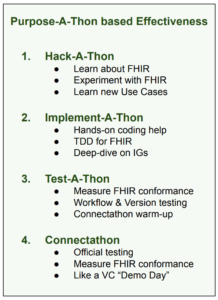Connectathons are at risk of devolving into check-the-box participation and demonstration events. Let’s fix that.
Not that long ago, health IT implementers attended annual (IHE) Connectathon events to test and polish their nearly-ready-for-production (most advanced) implementations. This was (and they still are) a big deal, with significant costs to register, prepare and attend.
IHE Connectathon organizers and volunteers spent years to improve and refine the rigor—and value—of these events by maturing testing tools, calibrating tests and engaging expert monitors to measure implementation conformance to IHE published profiles. Not meeting these expectations meant potentially missing a key go-live (and usually certification) milestone. The stakes were high, and implementation teams worked all-out to be prepared.
Since late 2012, 30 Health Level Seven (HL7®) Fast Healthcare Interoperability Resources (FHIR®) Connectathons have taken place; AEGIS is proud to have been an early sponsor and continuous supporter of these events, and we applaud the vision of successive ONC teams and countless HL7 volunteers to fund and lead these events.
As the healthcare industry evolves to promote patient engagement and empowerment to improve care coordination and produce better outcomes across an integrated ecosystem, FHIR continues to garner the attention of wider audiences. Our FHIR implementation community is growing rapidly, and the number of Connectathon events has multiplied. We still benefit from the IHE Connectathons (which can include a pre-event hackathon), and we now have those frequent HL7 FHIR Connectathon events (and AEGIS continues to support), along with CMS Connectathons and other Connectathon-like events. That’s great; we want lots of engagement from our growing implementation community.
Recent FHIR Connectathons: Good News; Bad News
FHIR Connectathons, in fact, are a key milestone in the approval process by the HL7 FHIR Management Group (FMG) for getting an IG published by HL7. The good news here is that this is a path to “calibrate the specs” against what the real-world implementation community experiences. Connectathons should be one of the last steps before the “real world”—assuming that we objectively test the implementations to assess implementer interpretations of the draft standard or published IG (i.e., measure conformance) against reference implementation(s).
The bad news is that Connectathons have teams attending for a variety of purposes, so the chances of calibrating IGs against real-world implementations are fleeting. Attendees are everywhere on the implementation maturity spectrum, from almost-ready-for-production to still-implementing, to struggling-to-implement, to starting-to-implement, to planning-to-implement to FHIR-beginners. We have even seen recent FHIR Connectathon events including actual development of the standard itself. These varying needs do need to be met, of course, but satisfying them doesn’t fit the current “Connectathon” model, and it shows.
Natural Outcome of Community Growth
It’s tempting to argue that implementing FHIR is way easier than implementing earlier healthcare standards (HL7 V2, XML/WSDL, SAML, etc.); that was certainly the goal of the FHIR architects. Some may argue this point, but let’s agree for the moment that this is true. Even so, this overlooks the fact that many implementers in our growing implementation community are relatively new to healthcare.
Put another way, as our implementation community expands beyond the relatively small cohort of early adopters, our newer community members are sending us pretty strong signals, via their varying levels of FHIR maturity, that they need more than the one-size-fits-all limitations of the current Connectathon format.
These cross-purposes are in conflict with each other and with the FHIR community’s interests. What would be the assessed value of a FHIR IG being presented in a FHIR Connectathon, testing with several participants, but not measuring conformance of the FHIR messages or the FHIR Server’s actual implementation to the IG’s? Has that FHIR IG met the objective and purpose of the FHIR Connectathon?
We are certain we can do better!
Let’s Meet Implementers Where They Are
Rather than continuing to hope that all implementers are in the same place on their health IT/FHIR learning curve, we suggest the following set of events, culminating in effective Connectathons, so that the time we all spend together is the most productive for everyone in the community. Let’s meet each attendee where they are with targeted, time-efficient, events catering to each stop on the FHIR implementation learning curve:
 Beginners, teams introducing new use cases, and those planning their implementation attend the Hack-A-Thon to try out FHIR while we actively help them: to learn by failing, to really understand FHIR use cases and IGs, to start their FHIR journey with community assistance, to start building out the test cases and test methods.
Beginners, teams introducing new use cases, and those planning their implementation attend the Hack-A-Thon to try out FHIR while we actively help them: to learn by failing, to really understand FHIR use cases and IGs, to start their FHIR journey with community assistance, to start building out the test cases and test methods.
Teams in the thick of implementations attend the Implement-A-Thon to get hands-on help with those tricky FHIR nuances and the details of the IG’s they are implementing. They will also experience how testing during development (TDD) accelerates their implementation while baking in syntactic interoperability. We help them configure FHIR Validators for their implementation scope and we start evaluating the implementation’s coverage of IG functionality, the underlying Reference Implementation (RI), and we start calibrating the test tooling.
Teams attend the Test-A-Thon (effectively a “pre-Connectathon”) to work out the “other 90 percent” that the “last 10 percent” inevitably involves. With a focus on ensuring compliance and conformance to the specification, we help these teams ensure that their implementation has a valid capability statement, and is able to execute a well-orchestrated workflow across an integrated ecosystem where the context of the patient and semantic interoperability are tested. Product vendors can test multi-version support, backward compatibility, and future-proof their products.
Fueled by the preceding efforts, implementations will reflect more consistent IG/standards interpretation, and the Connectathon will be restored to “THE event”; the coming-out party for implementations that demonstrate the highest degree of measurable conformance and rigor commensurate with products worthy of attaining future certification.
This vision of Connectathon Effectiveness is Reality Today
Da Vinci and CARIN Accelerators demonstrate the “ideal” Connectathon vision now, working through the IG authoring and development lifecycle to ensure that their Connectathon tracks show tested implementations, full-featured demonstrations, and objective conformance reporting. We have this model now. (Wow!)
But Who Has Time for All This?
Great question! It really is a shame that we are all spending so much time going through the motions, trying to make a single “Connectathon” event work for all the different cohorts in our community. The time we waste spinning our wheels explaining and re-explaining before, during and after each Connectathon could certainly be better spent intentionally assisting teams through the FHIR implementation learning curve. We already have teams seeking the help described above; they aren’t finding that help at our single Connectathon event is wasting everyone’s time.
Let’s be intentional about meeting these needs, and devise a schedule and format to make it happen. Beginners aren’t going to go from Hackathon to Connectathon in a single Connectathon week; in fact, it is unlikely that teams early in their implementation effort will either. That’s OK, because it isn’t happening now. The benefit of intentionality here is that we can focus effort and time on these cohorts to help them accelerate their learning curve journey, then focus our attention on the groups who are ready for testing and “almost-live” demonstrations.
Call to Action
As mentioned above, the FHIR implementation community is rapidly maturing—as all movements do that enjoy real traction. What got us here won’t get us where we need to be; we are at the crossroads between early adopters/fast-followers and widespread adoption, but our recent experiences with a one-size-fits-all Connectathon format vividly demonstrate that we are not ready to scale our community.
Let’s not squander this opportunity; let’s align our Connectathon approach to the demonstrated needs of our growing community so that this wave of interest is effectively harnessed into more FHIR adoption and those better outcomes for patients, providers, and payers.


4 thoughts on “What the “Heck-a-thon””
It’s clear that as we transition from early-adoption to Industry-adoption scale, that it’s time to accelerate all levels as the industry has out grown a one-size fits all events and programs cycle. Agreed, opportunity abounds to segment the user base and now engage the users at their levels as discussed. This should be a clear calling to industry execs and govt. leaders to recognize the powerful community and the possible impacts with discrete goals and aggressive support.
Paul, I agree that wider industry-adoption remains the goal, and “At Scale” now figures into a lot of these conversations. You are correct one-size may not fit all; however, we want to be careful not to fractionalize the community by “segment the user base” … we are still a community by-and-large. But whole heartily agree this is a definite calling to “industry execs and govt. leaders” to recognize the power of this community and the “art of” the possible. Appreciate the support and feedback.
I think there are a few more types of events. I do agree that more types of events will be exhausting to those compelled to participate in all of them. I think this is the critical concern to solve.
https://healthcaresecprivacy.blogspot.com/2013/11/what-is-connectathon.html
John, appreciate the feedback (and link back to your earlier Blog Post), completely agree; now what do you suggest? Count us in!